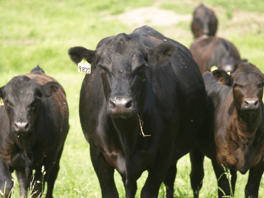
Field days have long been a great educational tool used to show farmers new technologies and management practices. OSU Extension is pleased to announce the return of a statewide Ohio Beef Cattle Field Day. It has been several years since an Ohio Beef Field Day has been held, and the program will make it reappearance in Muskingum County on Saturday, July 16, 2022.
In order to see several aspects of beef cattle production, this event will begin with a Muskingum Livestock, 944 Malinda St. Zanesville where we will gather before departing on a multiple stop tour in the Adamsville area. The tour will depart with attendees driving their own vehicles as we caravan from one stop to the next. We recommend carpooling as much as possible due to limited parking at one of the tour stops.
The tour stops are as follows:
Michel Livestock is a diversified farm operation, where Dennis Michel manages the cattle feeding operation. On the farm, they maintain around 150 beef cows, feed nearly 700 head of cattle at any one time, and row crop farm several hundred acres of crops. The focus of this stop will be facility design and cattle receiving. Michel Livestock maintains a near-continuous flow of purchased cattle into their receiving barns and markets fat cattle on a weekly basis. The Michel family also owns and operates Farm Supply Center in Zanesville, where they mix and sell feed and fertilizer.
Shirer Brothers Processing is one of several small meat processors in Muskingum County. The business recently transitioned principal operators, as Seth Scheffler has taken over operations from the Shirer family. Joining us at this stop will be Peggy Hall, Ag Law Field Specialist for OSU Extension. At this stop, we will discuss the local meat industry and address any questions attendees may have regarding direct-to-consumer meat sales.
Our third stop will be at Hatfield Farms and Fencing operated by Wade and his son, Wesley Hatfield. From having a small herd of cattle and a fencing business, the Hatfields were able to grow the cattle enterprise when Wesley returned to the farm. Currently, they maintain nearly 200 cows including several that calve in the fall. When it comes to raising beef cattle they have experimented with different management strategies. We will hear from the Hatfields as to what works well, what they would do differently, and get some tips on proper fence building techniques.
We will conclude the program at a Roger’s Auction Barn, a local landmark owned and operated by Roger and Dianne Kreis for many years. The Muskingum County Cattlemen will be preparing lunch. During lunch, representatives from the Ohio Beef Council will be highlighting some recent programming and sharing some insight into consumer trends. We will wrap up the day with Dr. Justin Kieffer, Clinical Veterinarian at the OSU Department of Animal Science discussing herd health updates and anaplasmosis management.
Pre-registration for the program is required and can be completed online at go.osu.edu/2022beefday by July 7. The program fee is $10 per person to cover costs. An information folder, refreshments, lunch, and Beef Quality Assurance certification will be provided to all attendees. If there are any questions regarding the program contact Garth Ruff, Beef Cattle Field Specialist at ruff.72@osu.edu or 740-305-3201. We hope to see you in Muskingum County on July 16.
FLYER






